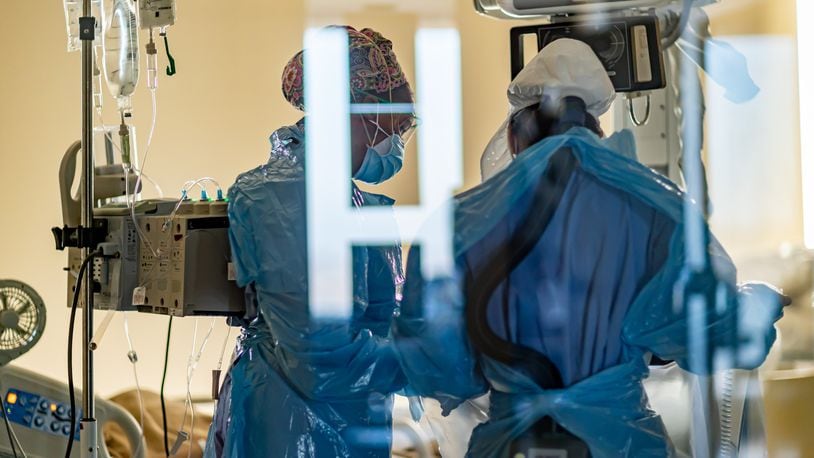The wider Midwestern region is faring even worse. In northeastern Ohio, admissions for COVID-19 are at an all-time high. Ohio and neighboring states are ranked highest nationwide for hospitalizations per 100,000 residents.
“We’re not quite at our all-time peak yet,” said Sarah Hackenbracht, president and CEO of the Greater Dayton Area Hospital Association. “But every day we keep inching closer and closer to that number in a timeframe where that really shouldn’t be our reality. In December 2020, we didn’t have a vaccination at all. There was no solution. Now we have a vaccine that is proven safe and effective.”
Last week, 87% of patients hospitalized for COVID-19 at Premier Health and Kettering Health hospitals were unvaccinated. About 54% of all Ohioans are fully vaccinated.
There were 1,002 patients hospitalized with COVID-19, including 239 patients in the intensive care unit and 152 patients on ventilators, in the Dayton-Cincinnati area on Wednesday. Those figures include the Ohio Hospital Association’s West Central region (Champaign, Clark, Greene, Miami, Montgomery, Preble, Darke and Shelby counties) and its Southwest region (Butler, Warren, Clinton, Hamilton, Clermont, Highland, Brown and Adams counties).
Sara Paton, an epidemiology professor at Wright State University, said it’s difficult to say definitively why coronavirus hospitalizations are surging.
“But we are just coming off of the Thanksgiving holiday,” she said. “We were going down but then we all got together and spread the disease more. We still have a large portion of our population in Ohio that haven’t been vaccinated. And even though it’s been around a lot, there’s still a lot of people that haven’t had COVID. And Delta is more transmissible (than the variants that dominated the U.S. last winter).”
Heading into Christmas and New Year’s, hospital leaders are concerned that people don’t realize how bad things are and have stopped following precautions.
“There are many, many people in our community who are ready to celebrate being through this pandemic and from a hospital perspective, we are very, very far away from being through this pandemic,” Hackenbracht said. “Remember: Stay home if you’re ill and distance yourself from individuals if you don’t know their vaccination status.”
At 42 COVID hospitalizations per 100,000 residents, Ohio currently ranks as the third highest state for hospitalizations, according to the New York Times. Ohio’s neighbors, which have similar vaccination rates, are also being hit hard: Michigan ranks first, Indiana ranks second and Pennsylvania ranks fourth for hospitalizations per 100,000 residents.
Ohio reported 10,588 COVID-19 cases on Wednesday, including about 840 cases that were part of a backlog, according to the Ohio Department of Health. When excluding those cases, Ohio recorded 9,748 cases in the last day. It would be the highest number of cases reported in the last 21 days and only the third time in the last three weeks daily cases exceeded 9,000.
Cleveland-area hospitals last week announced they are postponing some nonessential surgeries that would take up hospital beds as the region battles more COVID hospitalizations than ever before. Reid Health hospital network — which has locations in Eaton, Greenville and Indiana — reported this week that it doesn’t have enough room or staff to care for more patients.
“Area health systems are being overrun with COVID-19 cases, leaving few to no resources for other medical needs,” Reid Health said in a statement.
Nonessential services are continuing at Premier, Kettering and Mercy Health facilities, Hackenbracht said.
“Kettering Health remains capable of caring for all patients, including those with COVID-19,” said a statement from the hospital network.
Also alarming health leaders is the return of flu, Hackenbracht said. Hospitalizations for flu in the Dayton area are so far this season following the five-year trendline. Last year, when people were masking and distancing and schools were operating remotely, flu season proved extremely mild. But without those measures in place, Ohio could see thousands of hospitalizations from flu this year. In the four annual flu seasons before 2020-2021, Ohio saw between 8,600 and 11,000 flu-related hospitalizations each season.
About the Author
